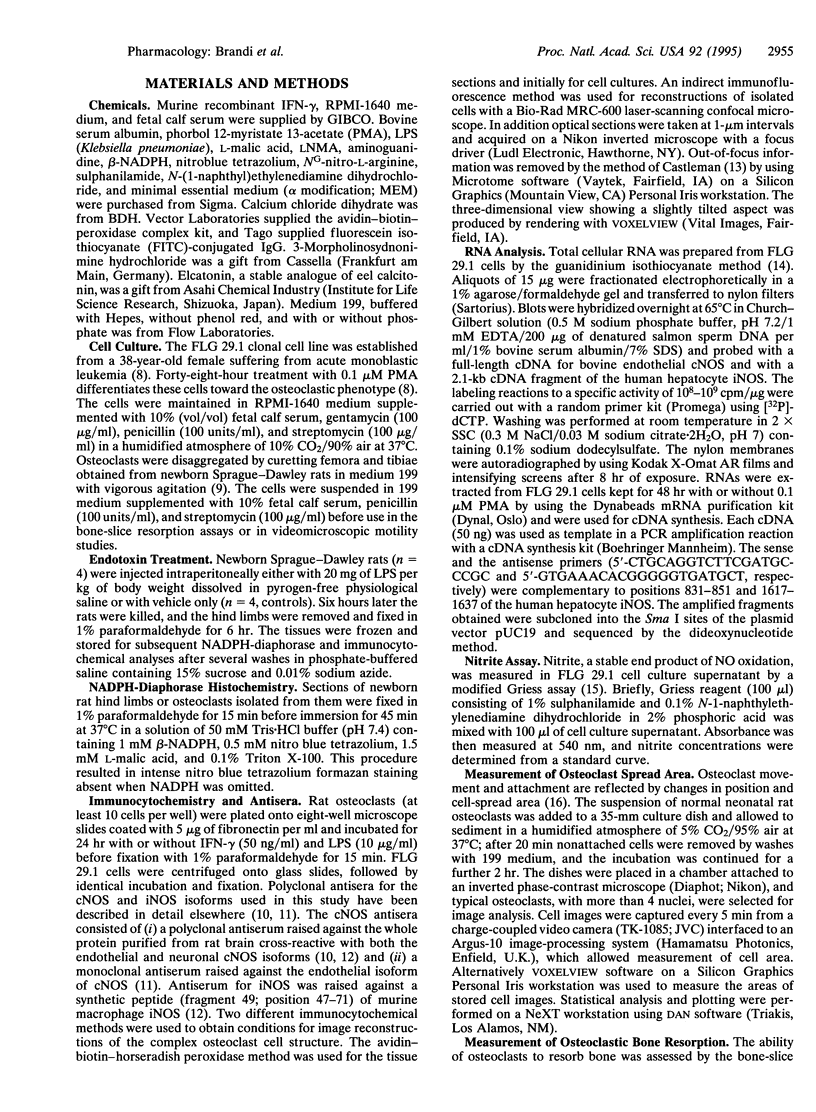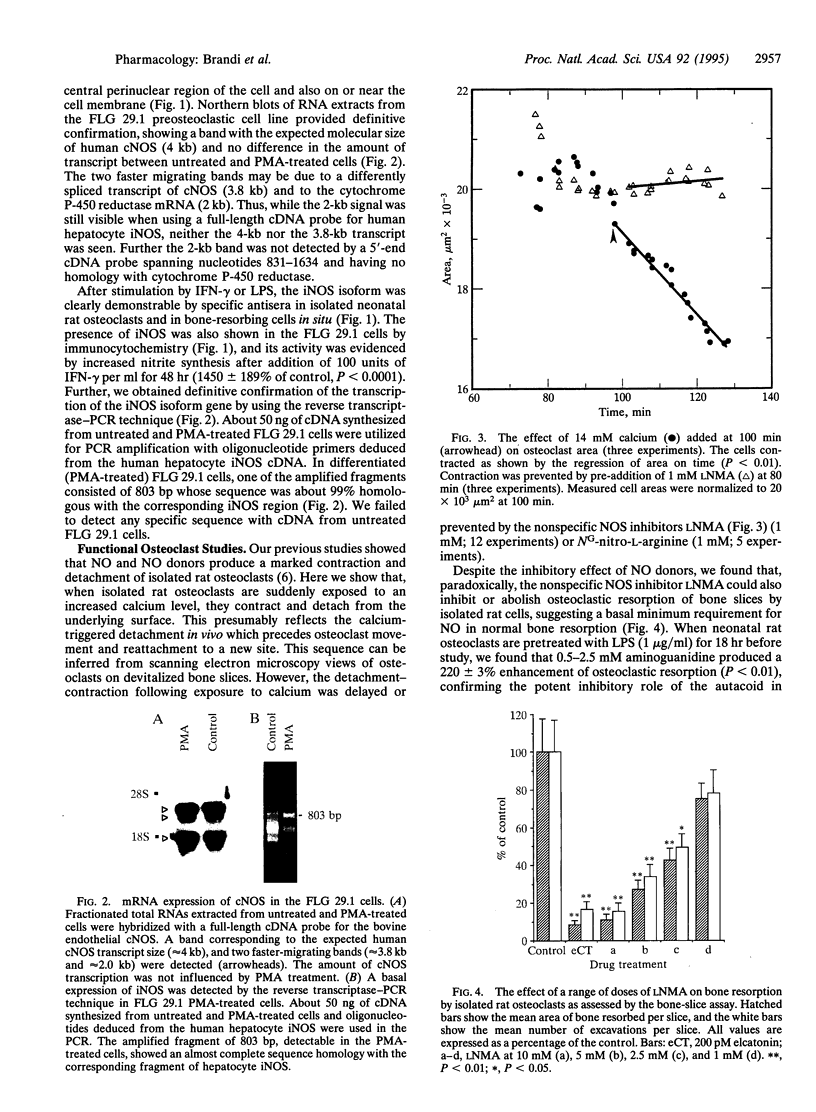Abstract
Nitric oxide (NO) produces rapid osteoclast detachment and contraction in vitro, and this effect is accompanied by a profound inhibition of bone resorption. Work by others has confirmed these findings in vivo: inhibition of NO synthase [NOS; L-arginine, NADPH: oxygen oxidoreductase (NO-forming), EC 1.14.13.39] in normal rats is followed by increased bone resorption reflected by a marked loss in bone mineral density. In our present study, immunocytochemistry and Northern blotting show the presence of the constitutive calcium-sensitive NOS isoform (cNOS) in normal rat osteoclasts and in the human preosteoclast cell line (FLG 29.1). The inducible NOS isoform (iNOS) was also clearly demonstrable in the rat cells especially after treatment with gamma interferon (IFN-gamma) and bacterial wall products [lipopolysaccharide (LPS)], while a basal level of transcript was detected in the untreated human preosteoclast line. However NADPH-diaphorase activity was intense only in neonatal rat osteoclasts attached to bone, perhaps reflecting either enhancement of cNOS activity by calcium or increased amounts of the inducible isoform in activated osteoclasts in situ compared with isolated neonatal rat osteoclasts. These actively resorb devitalized bone but the untreated cells contain relatively low levels of NOS; they are extremely sensitive to inhibition by NO. The iNOS inhibitor aminoguanidine markedly enhances in vitro resorption by activated NOS-rich chick osteoclasts and by normal rat osteoclasts treated with LPS or IFN-gamma. In contrast, the nonselective NOS inhibitor NG-monomethyl-L-arginine inhibits resorption by untreated neonatal rat osteoclasts. Thus, osteoclast function may require intermittent calcium-stimulated increases in NO production by cNOS against a basal inhibitory background activity of the iNOS isoform. However, bone resorption depends on precursor replication and on the activity of the mature cells, and we found that the NO donor 3-morpholinosydnonimine (SIN-1) (50 microM) profoundly depressed replication in the human preosteoclast line. Taken together, these results strongly suggest that NO maintains a central control of bone resorption in both avian and mammalian species by exerting a powerful tonic restraint of osteoclast numbers and activity. The presence of NOS in human cells implies a similar function in man and that conventional views of calcium homoeostasis and skeletal metabolism will need substantial revision. Since NO also influences behavior of the osteoblast, the bone-forming cell, in vitro, a similar effect in vivo might imply a general influence on bone remodeling.
Full text
PDF




Images in this article
Selected References
These references are in PubMed. This may not be the complete list of references from this article.
- Bredt D. S., Hwang P. M., Glatt C. E., Lowenstein C., Reed R. R., Snyder S. H. Cloned and expressed nitric oxide synthase structurally resembles cytochrome P-450 reductase. Nature. 1991 Jun 27;351(6329):714–718. doi: 10.1038/351714a0. [DOI] [PubMed] [Google Scholar]
- Chambers T. J. Osteoblasts release osteoclasts from calcitonin-induced quiescence. J Cell Sci. 1982 Oct;57:247–260. doi: 10.1242/jcs.57.1.247. [DOI] [PubMed] [Google Scholar]
- Chomczynski P., Sacchi N. Single-step method of RNA isolation by acid guanidinium thiocyanate-phenol-chloroform extraction. Anal Biochem. 1987 Apr;162(1):156–159. doi: 10.1006/abio.1987.9999. [DOI] [PubMed] [Google Scholar]
- Gattei V., Bernabei P. A., Pinto A., Bezzini R., Ringressi A., Formigli L., Tanini A., Attadia V., Brandi M. L. Phorbol ester induced osteoclast-like differentiation of a novel human leukemic cell line (FLG 29.1). J Cell Biol. 1992 Jan;116(2):437–447. doi: 10.1083/jcb.116.2.437. [DOI] [PMC free article] [PubMed] [Google Scholar]
- Geller D. A., Lowenstein C. J., Shapiro R. A., Nussler A. K., Di Silvio M., Wang S. C., Nakayama D. K., Simmons R. L., Snyder S. H., Billiar T. R. Molecular cloning and expression of inducible nitric oxide synthase from human hepatocytes. Proc Natl Acad Sci U S A. 1993 Apr 15;90(8):3491–3495. doi: 10.1073/pnas.90.8.3491. [DOI] [PMC free article] [PubMed] [Google Scholar]
- Green L. C., Wagner D. A., Glogowski J., Skipper P. L., Wishnok J. S., Tannenbaum S. R. Analysis of nitrate, nitrite, and [15N]nitrate in biological fluids. Anal Biochem. 1982 Oct;126(1):131–138. doi: 10.1016/0003-2697(82)90118-x. [DOI] [PubMed] [Google Scholar]
- Hamid Q., Springall D. R., Riveros-Moreno V., Chanez P., Howarth P., Redington A., Bousquet J., Godard P., Holgate S., Polak J. M. Induction of nitric oxide synthase in asthma. Lancet. 1993 Dec 18;342(8886-8887):1510–1513. doi: 10.1016/s0140-6736(05)80083-2. [DOI] [PubMed] [Google Scholar]
- Kasten T. P., Collin-Osdoby P., Patel N., Osdoby P., Krukowski M., Misko T. P., Settle S. L., Currie M. G., Nickols G. A. Potentiation of osteoclast bone-resorption activity by inhibition of nitric oxide synthase. Proc Natl Acad Sci U S A. 1994 Apr 26;91(9):3569–3573. doi: 10.1073/pnas.91.9.3569. [DOI] [PMC free article] [PubMed] [Google Scholar]
- Lamas S., Marsden P. A., Li G. K., Tempst P., Michel T. Endothelial nitric oxide synthase: molecular cloning and characterization of a distinct constitutive enzyme isoform. Proc Natl Acad Sci U S A. 1992 Jul 15;89(14):6348–6352. doi: 10.1073/pnas.89.14.6348. [DOI] [PMC free article] [PubMed] [Google Scholar]
- Lowenstein C. J., Snyder S. H. Nitric oxide, a novel biologic messenger. Cell. 1992 Sep 4;70(5):705–707. doi: 10.1016/0092-8674(92)90301-r. [DOI] [PubMed] [Google Scholar]
- Löwik C. W., Nibbering P. H., van de Ruit M., Papapoulos S. E. Inducible production of nitric oxide in osteoblast-like cells and in fetal mouse bone explants is associated with suppression of osteoclastic bone resorption. J Clin Invest. 1994 Apr;93(4):1465–1472. doi: 10.1172/JCI117124. [DOI] [PMC free article] [PubMed] [Google Scholar]
- MacIntyre I., Zaidi M., Alam A. S., Datta H. K., Moonga B. S., Lidbury P. S., Hecker M., Vane J. R. Osteoclastic inhibition: an action of nitric oxide not mediated by cyclic GMP. Proc Natl Acad Sci U S A. 1991 Apr 1;88(7):2936–2940. doi: 10.1073/pnas.88.7.2936. [DOI] [PMC free article] [PubMed] [Google Scholar]
- Pollock J. S., Nakane M., Buttery L. D., Martinez A., Springall D., Polak J. M., Förstermann U., Murad F. Characterization and localization of endothelial nitric oxide synthase using specific monoclonal antibodies. Am J Physiol. 1993 Nov;265(5 Pt 1):C1379–C1387. doi: 10.1152/ajpcell.1993.265.5.C1379. [DOI] [PubMed] [Google Scholar]
- Springall D. R., Riveros-Moreno V., Buttery L., Suburo A., Bishop A. E., Merrett M., Moncada S., Polak J. M. Immunological detection of nitric oxide synthase(s) in human tissues using heterologous antibodies suggesting different isoforms. Histochemistry. 1992 Nov;98(4):259–266. doi: 10.1007/BF00271040. [DOI] [PubMed] [Google Scholar]
- Suda T., Takahashi N., Martin T. J. Modulation of osteoclast differentiation. Endocr Rev. 1992 Feb;13(1):66–80. doi: 10.1210/edrv-13-1-66. [DOI] [PubMed] [Google Scholar]
- Xie Q. W., Cho H. J., Calaycay J., Mumford R. A., Swiderek K. M., Lee T. D., Ding A., Troso T., Nathan C. Cloning and characterization of inducible nitric oxide synthase from mouse macrophages. Science. 1992 Apr 10;256(5054):225–228. doi: 10.1126/science.1373522. [DOI] [PubMed] [Google Scholar]
- Zaidi M., Chambers T. J., Bevis P. J., Beacham J. L., Gaines Das R. E., MacIntyre I. Effects of peptides from the calcitonin genes on bone and bone cells. Q J Exp Physiol. 1988 Jul;73(4):471–485. doi: 10.1113/expphysiol.1988.sp003168. [DOI] [PubMed] [Google Scholar]
- Zaidi M., Datta H. K., Moonga B. S., MacIntyre I. Evidence that the action of calcitonin on rat osteoclasts is mediated by two G proteins acting via separate post-receptor pathways. J Endocrinol. 1990 Sep;126(3):473–481. doi: 10.1677/joe.0.1260473. [DOI] [PubMed] [Google Scholar]




